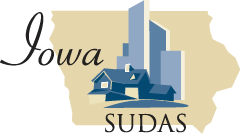About SUDAS
What Is SUDAS?
SUDAS (pronounced “soo’dahs”) is short for Statewide Urban Design and Specifications. The Institute for Transportation at Iowa State University maintains Iowa’s SUDAS manuals for public improvements. Developing and maintaining Iowa’s unique SUDAS manuals is the result of a lengthy and painstaking effort by more than 300 stakeholders across the state.
A brief history
In the late 1980s, 16 central Iowa urban jurisdictions, including the City of Des Moines, surrounding cities, and two counties, began meeting to discuss developing common urban standards for public improvements. Such improvements include sanitary sewers and water mains, streets and sidewalks, utility locations, signalization, drainage and erosion control, etc.
Developing common standards among several jurisdictions was breaking new ground in Iowa, and the group made slow but deliberate progress.
Their efforts came into focus when, in 1995, Governor Terry Branstad assembled a Blue Ribbon Task Force on Transportation to investigate ways to use Iowa’s Road Use Tax Fund more efficiently. One of the task force’s recommendations was that agencies “adopt common standards for construction specifications . . . .” By 1998, the central Iowa group (known as the Central Iowa Committee) had expanded to 34 Iowa jurisdictions, including several communities outside the Des Moines area and had published their design standards and specifications.
In 2000, the effort was underway to further expand the number of cities using the Central Iowa Committee’s manuals and to convert them to statewide manuals, eventually known as the SUDAS program.
A statewide steering committee, comprised of various stakeholder groups, including Iowa DOT, cities, counties, and consultant and industry groups, was organized in 2002 to oversee the new SUDAS program. Iowa State University’s Center for Transportation Research and Education (CTRE) (CTRE was renamed to the Institute for Transportation or InTrans in 2009) was chosen to manage the program.
In 2004, a new nonprofit entity was created to establish a mechanism for statewide ownership: the Iowa SUDAS Corporation. The Board of Directors for the corporation consists of members who formerly served on the statewide steering committee, with the addition of a few others. InTrans continues to manage the program.
On February 17, 2005, the Central Iowa Committee acted to officially transfer ownership of the manuals to the Iowa SUDAS Corporation. Statewide ownership of the manuals makes them truly the statewide standards for urban public works improvements.
InTrans continues to manage the SUDAS program. Check out our flyer about the program.
Who’s paying
Through metropolitan planning organizations, regional planning authorities, and transportation management agencies, Iowa’s local communities are covering nearly 60% of SUDAS development costs. The Iowa DOT pays the balance.
Advantages of using SUDAS
First of all, citizens simply appreciate uniform public improvements (e.g., similar sidewalk ramps) from town to town. In addition, by using standard designs and specifications Iowa’s cities have
- Uniformity of urban design and specifications across the state
- Reduction of contractor confusion and mistakes due to differing specifications; encourages more bidders
- Mechanism to be proactive in research and studies for new and improved urban design and specifications
- Method for study and statewide implementation of latest techniques and material use
- Forum that allows state and local governments to collaborate with industry
- Reduced costs through uniformity, understanding, and acceptance (conservatively estimated at $16M/year if program is fully implemented)
Finally, InTrans keeps the statewide manuals up to date. This relieves individual communities of that burden and expense while ensuring they are informed about new products and procedures.
How to get the manuals
Electronic versions of the Design and Specifications manuals can be downloaded from this site. Printed manuals be ordered by filling out the manual order form.
How to get new products added to the manuals
Introduction of a new product starts with a user identifying a product they have used successfully and would enhance the SUDAS manuals. This suggestion is made at one of our three regional committee meetings held three times each year throughout the state. These meetings cover revisions and additions to the manuals and are attended by approximately 100 engineers representing cities, counties, Iowa DOT, and consultants from all areas of the state. Following the initial suggestion at one region, the idea or product is proposed to the other two regions to determine interest in adding to the manuals. If the response is affirmative, design and/or specifications information is developed. However, we do not list specific products in the SUDAS Manuals. From there the three regional committees vote to add/modify or reject the language. If it is recommended by a majority of the regional committees, it moves forward to the SUDAS Board of Directors for final action. If the Board approves, the language will be added in the next edition of the manual(s), which are generally issued in December for the following year.
The SUDAS Manuals specifically state that any new products meeting the needs of a project can be added through the use of supplemental specifications or a special provision. This process is generally the way new products are tried.
